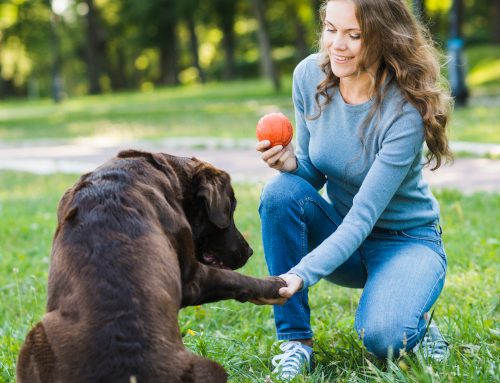Summer time with its higher heat and humidity can be a challenging time for pet owners. High temperatures and humidity can lead to heatstroke, dehydration, and other health problems for dogs. That’s why it’s essential to take steps necessary to keep your furry friend cool and comfortable during the hot months. This article covers the top ways to keep your dog comfortable during the summer, first aid for overheated pets and when it’s time for veterinary interaction.
Steps to Keep Your Dog Comfortable in the Heat
1. Never Leave Pets Unattended in a Parked Car
It’s critical that you do not leave your pet in a hot vehicle. In only a few minutes, the inside temperature of a car can reach 120 degrees or more, even with the windows partially open.
 2. Provide plenty of fresh water
2. Provide plenty of fresh water
One of the most important things you can do to keep your dog cool in the summer heat is to provide them with plenty of fresh, clean water. Make sure your dog has access to water at all times, and check their bowl regularly to ensure that it’s full.
3. Use a cooling mat
Cooling mats are a great way to help your dog regulate their body temperature. They work by absorbing and dissipating heat, keeping your dog cool and comfortable. You can find cooling mats at your local pet store or online.
4. Keep your dog indoors during the hottest part of the day
The hottest part of the day is typically between late morning and afternoon. During this time, it’s best to keep your dog indoors in a cool, air-conditioned room. If you don’t have air conditioning, consider using a fan to circulate the air and keep your dog cool.
5. Freeze treats and toys
Another way to keep your dog cool is to freeze their favorite treats and toys. Fill a Kong toy or other chew toy with peanut butter or another tasty treat, then freeze it overnight. Your dog will love licking and chewing on the cold toy, and it will help keep them cool.
6. Provide shade
If your dog spends time outdoors, make sure they have access to shade. Set up a canopy, umbrella, or other shade structure in your yard to give your dog a place to rest and cool off.
7. Use a kiddie pool
Dogs love playing in water, and a kiddie pool can be a great way to help them cool off. Fill the pool with a few inches of water and let your dog splash around and have fun.
8. Use a cooling vest
Cooling vests are another great option for keeping your dog cool. These vests work by circulating cool water through a series of tubes or chambers, helping to regulate your dog’s body temperature. You can find cooling vests at most pet stores or online.
9. Trim your dog’s fur
If your dog has long hair, consider trimming it during the summer months. This will help them stay cool and comfortable, and it can also make grooming and bathing easier.
10 Avoid hot surfaces
Hot pavement, asphalt, and sand can burn your dog’s paw pads and make them very uncomfortable. When you take your dog for a walk, try to stick to grassy areas or shaded paths.
Signs of Heatstroke in Dogs
Before we dive into first aid for an overheated dog, let’s talk about the signs of heatstroke. If your dog is exhibiting any of the following symptoms, they may be suffering from heatstroke:
- Excessive panting and drooling
- Red or pale gums
- Rapid heartbeat and breathing
- Vomiting and diarrhea
- Weakness and collapse
First Aid for Heatstroke
If you suspect that your dog is suffering from heatstroke, it’s important to act quickly. Here are the urgent steps for you to take:
Move your dog to a cool, shaded area
The first thing you should do is move your dog to a cool, shaded area. If possible, bring them inside where there is air conditioning.
Offer water
Provide your dog with fresh, cool water to drink. Don’t force them to drink, but encourage them to take small sips.
Cool your dog down
Use cool water to wet your dog’s fur and skin. You can use a hose, wet towels, or a cool bath. Avoid using cold water or ice, as this can cause the blood vessels to constrict and prevent the body from cooling down.
Use a fan
Use a fan to circulate the air around your dog to help them cool down.
Monitor your dog’s temperature
Use a rectal thermometer to monitor your dog’s temperature. A normal temperature for dogs is between 99.5°F and 102.5°F. If your dog’s temperature is above 103°F, it’s time to call the vet, see the next section.
When to Involve a Veterinarian
While first aid can be helpful in treating heatstroke, it’s important to know when to involve a veterinarian. If your dog’s temperature is above 103°F, or if they are exhibiting signs of severe heatstroke, or their condition is not improving with first aid, consider this an emergency and immediately take your dog to your veterinarian. At the vet’s office, treatment may include IV fluids to rehydrate your dog, medications to treat any secondary conditions, and monitoring of vital signs.
Recap
Keeping your dog cool in the summer heat is crucial for their health and well-being. By following these tips, you can help ensure that your furry friend stays comfortable and safe during the hot months. Remember to never leave your pets alone in a car, provide plenty of fresh water, use cooling mats and vests, and avoid hot surfaces. With a only a little extra effort, you can make sure that your dog stays cool and happy all summer long.
References:
Keep pets safe in the heat” The Humane Society of the United States, https://www.humanesociety.org/resources/keep-pets-safe-heat
“How Hot is Too Hot? Heatstroke in Dogs” American Kennel Club, American Kennel Club, May 6, 2021 https://www.akc.org/expert-advice/health/heat-stroke-in-dogs/
“Keep Pets Safe in Hot Weather” American Red Cross, 2022, https://www.redcross.org/about-us/news-and-events/news/2022/keep-pets-safe-in-hot-weather.html
DISCLAIMER:
We use affiliate links and pay-per-action advertising. When you use these links to buy something we may earn a commission. Thank you for visiting and for your support.
PetsWebPages.com may contain copyrighted material. This use may not have been specifically authorized by the copyright owner. The material contained in this website is distributed for informational and educational purposes. Small portions of the original work may have been used but those portions could not easily be used to duplicate the original work. This usage constitutes ‘fair use’ of any such copyrighted material (referenced and provided for in section 107 of the US Copyright Law).
All trademarks displayed here are the property of their owners and are neither an endorsement nor a recommendation for or from those organizations. With the exception of affiliate links, linking to the websites of third-party organizations is not intended to imply we recommend those organizations or that the organizations endorse or have any affiliation with PetsWebPages.com.





